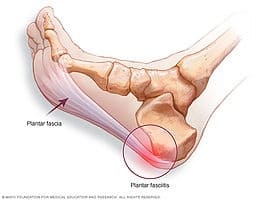Hello and welcome to our plantar fasciitis series! The blogs in this series will discuss “what is plantar fasciitis” and foot pain in general, how to avoid mistakes that lead to worsening of plantar fasciitis, common causes, and the best treatments.
This installment focuses on the question “what is plantar fasciitis and how do I know if I have it?”
What else could it be?
There are a variety of conditions that can contribute to pain in the foot. For example, posterior tibialis tendonitis (PTT) is another inflammatory condition with similar causes to plantar fasciitis, and the two often occur together. The pain from PTT would be along the medial ankle, while plantar fasciitis is typically along the heel.
https://img.clipartfest.com
Other things that may present similarly to plantar fasciitis include infectious, arthritic, traumatic, neurologic, or neoplastic (benign or malignant growth) conditions. This is why it is important to be evaluated by a healthcare practitioner well versed in differentiation of these conditions, such as your local doctor of physical therapy!
What is the plantar fascia anyway?
It’s quite a fancy name for something on the bottom of your foot but this name perfectly describes the anatomy of where the problem lies. “Plantar” refers to the bottom of your foot, “fascia” is the type of tissue. A fascia is a tough sheet of connective tissue beneath the skin that encloses and separates muscles and adds to stability. You have this stuff all over your body securing your muscles and other organs in place. The reason it’s so common for it to irritate at the foot is because of how much load we place through our feet daily.
The plantar fascia of your foot stretches from your medial heel bone (calcaneus) to the toes. To test if your plantar fascia is in tact, you can place your foot on the floor and gently pull up on your first toe, you should see your arch form, and with the other hand you should be able to feel a band push out from underneath your arch, this is known as the windlass mechanism. Tears in this plantar fascia cause pain that is referred to as “plantar fasciitis.”
How do I know if I have plantar fasciitis?
The hallmark complaint of people with plantar fasciitis is that they have heel pain with the first steps in the morning or after getting up from being off of their feet for a while. People may try to walk on their toes to alleviate this pain. There may also be a dull ache at the end of the day, and there may be some swelling.
Another positive finding for plantar fasciitis is if you are able to reproduce your pain with pulling up on your first toe while in seated. Due to the other things that can present as plantar fasciitis it is always recommended to consult with your physical therapist prior to attempting any self-treatment.
So What is Plantar Fasciitis? It’s a way to say you’ve torn the fascia in the bottom of the foot. The causes can vary. To learn more about potential causes for your plantar fasciitis read your tight calves are costing you.



